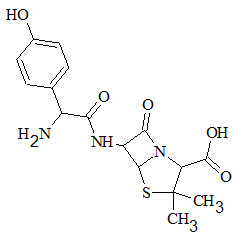
Bundle: Introduction to General, Organic and Biochemistry, 11th + OWLv2, 4 terms (24 months) Printed Access Card
11th Edition
ISBN: 9781305705159
Author: Frederick A. Bettelheim, William H. Brown, Mary K. Campbell, Shawn O. Farrell, Omar Torres
Publisher: Cengage Learning
expand_more
expand_more
format_list_bulleted
Question
Chapter 15, Problem 15.36P
Interpretation Introduction
Interpretation:
Label the four stereocentres in the given molecule of amoxicillin.

Concept Introduction:
The stereocentre is generated in an organic compound due to presence of chiral carbon.
The chiral carbon is the carbon bearing all the four groups different. Even isotopes are considered as different groups.
Expert Solution & Answer
Want to see the full answer?
Check out a sample textbook solution
Students have asked these similar questions
Use the Henderson-Hasselbalch equation to calculate pH of a buffer containing 0.050M benzoic acidand 0.150M sodium benzoate. The Ka of benzoic acid is 6.5 x 10-5
A. Draw the structure of each of the following alcohols. Then draw and name the product you would expect to produce by the oxidation of each. a. 4-Methyl-2-heptanol
b. 3,4-Dimethyl-1-pentanol
c. 4-Ethyl-2-heptanol
d. 5,7-Dichloro-3-heptanol
What is the pH of a 1.0 L buffer made with 0.300 mol of HF (Ka = 6.8 × 10⁻⁴) and 0.200 mol of NaF to which 0.160 mol of NaOH were added?
Chapter 15 Solutions
Bundle: Introduction to General, Organic and Biochemistry, 11th + OWLv2, 4 terms (24 months) Printed Access Card
Ch. 15.1 - Prob. 15.1PCh. 15.2 - Problem 15-2 Assign priorities to the groups in...Ch. 15.2 - Problem 15-3 Assign an R or S configuration to the...Ch. 15.3 - Problem 15-4 3-Amino-2-butanol has two...Ch. 15.3 - Prob. 15.5PCh. 15.3 - Prob. 15.6PCh. 15 - 15-7 Answer true or false. The cis and trans...Ch. 15 - 15-8 What does the term “chiral” mean? Give an...Ch. 15 - 15-9 What does the term “achiral” mean? Give an...Ch. 15 - 15-10 Define the term “stereoisomer.” Name three...
Ch. 15 - 15-11 In what way are constitutional isomers...Ch. 15 - 15-12 Which of the following objects are chiral...Ch. 15 - Prob. 15.13PCh. 15 - Prob. 15.14PCh. 15 - 15-15 Explain why the carbon of a carbonyl group...Ch. 15 - 15-16 Which of the following compounds contain...Ch. 15 - 15-17 Which of the following compounds contain...Ch. 15 - Prob. 15.18PCh. 15 - 15-19 Draw the mirror image for each molecule: OH...Ch. 15 - Prob. 15.20PCh. 15 - 15-21 Answer true or false. For a molecule with...Ch. 15 - Prob. 15.22PCh. 15 - Prob. 15.23PCh. 15 - Prob. 15.24PCh. 15 - Prob. 15.25PCh. 15 - 15-26 For centuries, Chinese herbal medicine has...Ch. 15 - Prob. 15.27PCh. 15 - Prob. 15.28PCh. 15 - Prob. 15.29PCh. 15 - 15-30 (Chemical Connections 15A) What does it mean...Ch. 15 - Prob. 15.31PCh. 15 - Prob. 15.32PCh. 15 - Prob. 15.33PCh. 15 - Prob. 15.34PCh. 15 - 15-35 Following are structural formulas for three...Ch. 15 - Prob. 15.36PCh. 15 - 15-37 Consider a cyclohexane ring substituted with...Ch. 15 - Prob. 15.38PCh. 15 - Prob. 15.39PCh. 15 - Prob. 15.40PCh. 15 - 15-41 Compound A(C5Hh, is not optically active and...Ch. 15 - Prob. 15.42PCh. 15 - 15-43 Triamcinolone acetonide, the active...Ch. 15 - 15-44 Consider the structure of the...Ch. 15 - Prob. 15.45PCh. 15 - 15-46 Consider Lunesta, a nonbenzodiazepine...Ch. 15 - Prob. 15.47P
Knowledge Booster
Similar questions
- Can I please get help with this.arrow_forwardDetermine if the following salt is neutral, acidic or basic. If acidic or basic, write the appropriate equilibrium equation for the acid or base that exists when the salt is dissolved in aqueous solution. If neutral, simply write only NR. Be sure to include the proper phases for all species within the reaction. N₂H₅ClO₄arrow_forwardPlease help me with identifying these.arrow_forward
arrow_back_ios
SEE MORE QUESTIONS
arrow_forward_ios
Recommended textbooks for you
 ChemistryChemistryISBN:9781305957404Author:Steven S. Zumdahl, Susan A. Zumdahl, Donald J. DeCostePublisher:Cengage Learning
ChemistryChemistryISBN:9781305957404Author:Steven S. Zumdahl, Susan A. Zumdahl, Donald J. DeCostePublisher:Cengage Learning ChemistryChemistryISBN:9781259911156Author:Raymond Chang Dr., Jason Overby ProfessorPublisher:McGraw-Hill Education
ChemistryChemistryISBN:9781259911156Author:Raymond Chang Dr., Jason Overby ProfessorPublisher:McGraw-Hill Education Principles of Instrumental AnalysisChemistryISBN:9781305577213Author:Douglas A. Skoog, F. James Holler, Stanley R. CrouchPublisher:Cengage Learning
Principles of Instrumental AnalysisChemistryISBN:9781305577213Author:Douglas A. Skoog, F. James Holler, Stanley R. CrouchPublisher:Cengage Learning Organic ChemistryChemistryISBN:9780078021558Author:Janice Gorzynski Smith Dr.Publisher:McGraw-Hill Education
Organic ChemistryChemistryISBN:9780078021558Author:Janice Gorzynski Smith Dr.Publisher:McGraw-Hill Education Chemistry: Principles and ReactionsChemistryISBN:9781305079373Author:William L. Masterton, Cecile N. HurleyPublisher:Cengage Learning
Chemistry: Principles and ReactionsChemistryISBN:9781305079373Author:William L. Masterton, Cecile N. HurleyPublisher:Cengage Learning Elementary Principles of Chemical Processes, Bind...ChemistryISBN:9781118431221Author:Richard M. Felder, Ronald W. Rousseau, Lisa G. BullardPublisher:WILEY
Elementary Principles of Chemical Processes, Bind...ChemistryISBN:9781118431221Author:Richard M. Felder, Ronald W. Rousseau, Lisa G. BullardPublisher:WILEY

Chemistry
Chemistry
ISBN:9781305957404
Author:Steven S. Zumdahl, Susan A. Zumdahl, Donald J. DeCoste
Publisher:Cengage Learning

Chemistry
Chemistry
ISBN:9781259911156
Author:Raymond Chang Dr., Jason Overby Professor
Publisher:McGraw-Hill Education

Principles of Instrumental Analysis
Chemistry
ISBN:9781305577213
Author:Douglas A. Skoog, F. James Holler, Stanley R. Crouch
Publisher:Cengage Learning

Organic Chemistry
Chemistry
ISBN:9780078021558
Author:Janice Gorzynski Smith Dr.
Publisher:McGraw-Hill Education

Chemistry: Principles and Reactions
Chemistry
ISBN:9781305079373
Author:William L. Masterton, Cecile N. Hurley
Publisher:Cengage Learning

Elementary Principles of Chemical Processes, Bind...
Chemistry
ISBN:9781118431221
Author:Richard M. Felder, Ronald W. Rousseau, Lisa G. Bullard
Publisher:WILEY